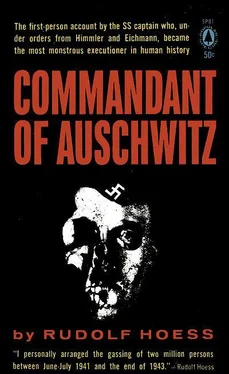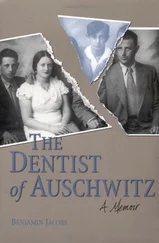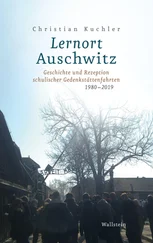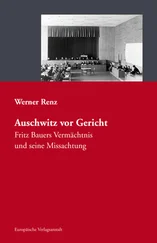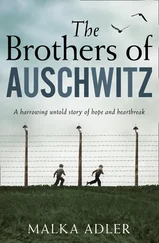In the autumn of 1941 a secret order was issued instructing the Gestapo to weed out the Russian politruks, commissars, and certain political officials from the prisoner-of-war camps, and to transfer them to the nearest concentration camp for liquidation. Small drafts of these prisoners were continually arriving in Auschwitz and they were shot in the gravel pit near the Monopoly buildings [106]or in the courtyard of block II. When I was absent on duty my representative, Hauptsturmführer Fritsch, on his own initiative, used gas for killing these Russian prisoners of war. He crammed the underground detention cells with Russians and, protected by a gas mask, discharged Cyclon B gas into the cells, killing the victims instantly.
Cyclon B gas was supplied by the firm of Tesch & Stabenow and was constantly used in Auschwitz for the destruction of vermin, and there was consequently always a supply of these tins of gas on hand. In the beginning, this poisonous gas, which was a preparation of prussic acid, was only handled by employees of Tesch & Stabenow under rigid safety precautions, but later some members of the Medical Service were trained by the firm in its use and thereafter the destruction of vermin and disinfection were carried out by them.
During Eichmann’s next visit I told him about this use of Cyclon B and we decided to employ it for the mass extermination operation.
The killing by Cyclon B gas of the Russian prisoners of war transported to Auschwitz was continued, but no longer in block II, since after the gassing the whole building had to be ventilated for at least two days.
The mortuary of the crematorium next to the hospital block was therefore used as a gassing room, after the door had been made gasproof and some holes had been pierced in the ceiling through which the gas could be discharged.
I can however only recall one transport consisting of nine hundred Russian prisoners being gassed there and I remember that it took several days to cremate their corpses. Russians were not gassed in the peasant farmstead which had now been converted for the extermination of the Jews.
I cannot say on what date the extermination of the Jews began. Probably it was in September 1941, but it may not have been until January 1942. The Jews from Upper Silesia were the first to be dealt with. These Jews were arrested by the Kattowitz Police Unit and taken in drafts by train to a siding on the west side of the Auschwitz-Dziedzice railroad line where they were unloaded. So far as I can remember, these drafts never consisted of more than 1,000 prisoners.
On the platform the Jews were taken over from the police by a detachment from the camp and were.brought by the commander of the protective custody camp in two sections to the bunker, as the extermination building was called.
Their luggage was left on the platform, whence it was taken to the sorting office called Canada situated between the DAW and the lumberyard. [107]
The Jews were made to undress near the bunker, after they had been told that they had to go into the rooms (as they were also called) in order to be deloused.
All the rooms, there were five of them, were filled at the same time, the gasproof doors were then screwed up and the contents of the gas containers discharged into the rooms through special vents.
After half an hour the doors were reopened (there were two doors in each room), the dead bodies were taken out, and brought to the pits in small trolleys which ran on rails.
The victims’ clothing was taken in trucks to the sorting office. The whole operation, including assistance given during undressing, the filling of the bunker, the emptying of the bunker, the removal of the corpses, as well as the preparation and filling up of the mass graves, was carried out by a special detachment of Jews, who were separately accommodated and who, in accordance with Eichmann’s orders, were themselves liquidated after every big action.
While the first transports were being disposed of, Eichmann arrived with an order from the Reichsführer SS stating that the gold teeth were to be removed from the corpses and the hair cut from the women. This job was also undertaken by the Special Detachment.
The extermination process was at that time carried out under the supervision of the commander of the protective custody camp or the Rapportführer. Those who were too ill to be brought into the gas chambers were shot in the back of the neck with a small-caliber weapon.
An SS doctor also had to be present. The trained disinfectors (SDG’s) were responsible for discharging the gas into the gas chamber.
During the spring of 1942 the actions were comparatively small, but the transports increased in the summer, and we were compelled to construct a further extermination building. The peasant farmstead west of the future site of crematoriums III and IV was selected and made ready. Two huts near bunker I and three near bunker II were erected, in which the victims undressed. Bunker II was the larger and could hold about 1,200 people.
During the summer of 1942 the bodies were still being placed in the mass graves. Toward the end of the summer, however, we started to burn them; at first on wood pyres bearing some 2,000 corpses, and later in pits together with bodies previously buried. In the early days oil refuse was poured on the bodies, but later methanol was used. Bodies were burned in pits, day and night, continuously.
By the end of November all the mass graves had been emptied. The number of corpses in the mass graves amounted to 107,000. This figure not only included the transports of Jews gassed up to the time when cremation was first employed, but also the bodies of those prisoners in Auschwitz who died during the winter of 1941-42, when the crematorium near the hospital building was out of action for a considerable time. It also included all the prisoners who died in the Birkenau camp.
During his visit to the camp in the summer of 1942, the Reichsführer SS watched every detail of the whole process of destruction from the time when the prisoners were unloaded to the emptying of bunker II. At that time the bodies were not being burned.
He had no criticisms to make, nor did he discuss the matter.
Gauleiter Bracht and the Obergruppenführer Schmauser were present with him.
Shortly after the visit of the Reichsführer SS, Standartenführer Blobel arrived from Eichmann’s office with an order from the Reichsführer SS stating that all the mass graves were to be opened and the corpses burned. In addition the ashes were to be disposed of in such a way that it would be impossible at some future time to calculate the number of corpses burned.
Blobel had already experimented with different methods of cremation in Culenhof and Eichmann had authorized him to show me the apparatus he used.
Hössler and I went to Culenhof on a tour of inspection. Blobel had had various makeshift ovens constructed, which were fired with wood and oil refuse. He had also attempted to dispose of the bodies with explosives, but their destruction had been very incomplete. The ashes were distributed over the neighboring countryside after first being ground to a powder in a bone mill.
Standartenführer Blobel had been authorized to seek out and obliterate all the mass graves in the whole of the eastern districts. His department was given the code number “1005.” The work itself was carried out by a special detachment of Jews who were shot after each section of the work had been completed. Auschwitz concentration camp was continuously called upon to provide Jews for department “1005.”
On my visit to Culenhof I was also shown the extermination apparatus constructed out of trucks, which was designed to kill by using the exhaust gases from the engines. The officer in charge there, however, described this method as being extremely unreliable, for the density of the gas varied considerably and was often insufficient to be lethal.
Читать дальше
